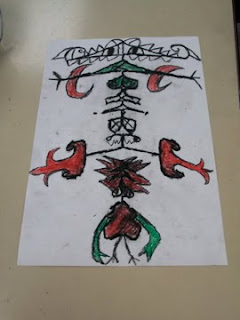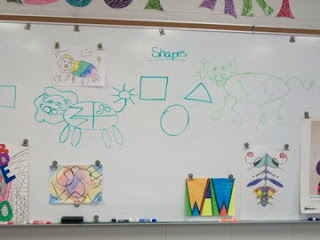Before embarking on a Still Life drawing, I make sure students understand Line, Shape, Space, and Color. I also teach how to draw by the way I know best... the way that I know. (i.e. my technique) I will not teach a technique until I understand it's ins and outs and I can teach it comfortably.
Materials: 12"x18" paper, pencil, liquid tempera paint, brushes size 12 & 14, and a round paint palette for each student, and foil to cover palettes
Materials: 12"x18" paper, pencil, liquid tempera paint, brushes size 12 & 14, and a round paint palette for each student, and foil to cover palettes
After going over Line, Shape, Space, and Color, we critique various still life paintings and drawings. I ask students how the artist would use certain lines, what shape would we start with to draw an apple, where are the grapes, and how did the artist use space?
I hammer these thoughts into their heads. Because when you draw a still life, you should ask yourself these questions.
What shape is this?
What line could I use to draw this?
How big is this?
Is this next to that?
Is it in the Foreground, Middle ground, Background?
I then show them I how would draw a still life step by step. However, I tell them that my steps beginning to end do not have to be theirs. I just want them to see how I am questioning myself as I draw things out.
My #1 rule in drawing anything: DRAW LIGHTLY! Until you commit yourself.
To start students chose one of 4 still life paintings that I displayed on the overhead to draw from. This way I can get some verity and not everyone is drawing the same thing.
Begin by thinking about Line, Shape, and Space as you are drawing.
This step took 1 & 1/2 5o minute class time.
Sorry I don't have a picture of the first step.
I demoed how I would begin to paint
The second step is to paint. Students have already completed a lesson on color theory and mixing their own color wheels. I give students only Red, Yellow, Blue, Black, and White.
I am so proud of their color mixing!
I let them choose the color of their tables and wall colors for their paintings.
The final step is to add shadows and highlights.
I hammer these thoughts into their heads. Because when you draw a still life, you should ask yourself these questions.
What shape is this?
What line could I use to draw this?
How big is this?
Is this next to that?
Is it in the Foreground, Middle ground, Background?
I then show them I how would draw a still life step by step. However, I tell them that my steps beginning to end do not have to be theirs. I just want them to see how I am questioning myself as I draw things out.
My #1 rule in drawing anything: DRAW LIGHTLY! Until you commit yourself.
To start students chose one of 4 still life paintings that I displayed on the overhead to draw from. This way I can get some verity and not everyone is drawing the same thing.
Begin by thinking about Line, Shape, and Space as you are drawing.
This step took 1 & 1/2 5o minute class time.
Sorry I don't have a picture of the first step.
I demoed how I would begin to paint
The second step is to paint. Students have already completed a lesson on color theory and mixing their own color wheels. I give students only Red, Yellow, Blue, Black, and White.
I am so proud of their color mixing!
I let them choose the color of their tables and wall colors for their paintings.
The final step is to add shadows and highlights.







 Posted by
Posted by






















































.jpg)
























































































